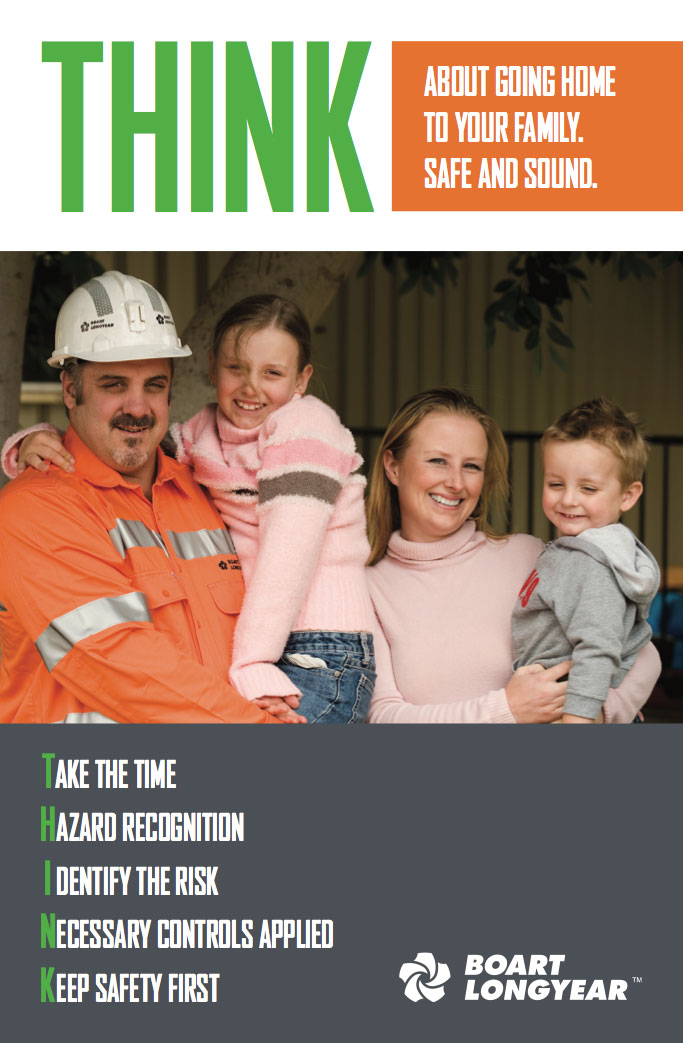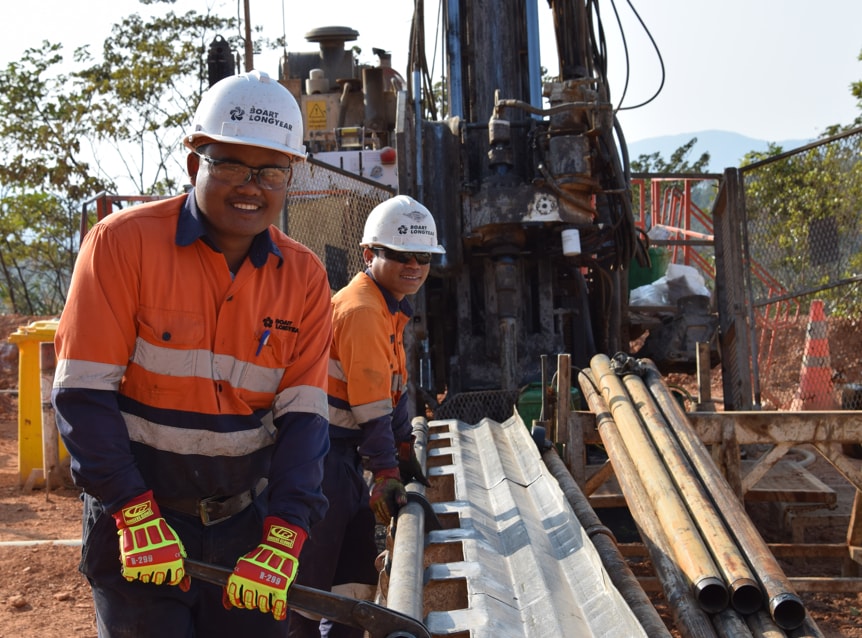SÉCURITÉ
18 septembre 2017
Assurer la sécurité des nouveaux départs lorsque le marché rebondit
Cet article a paru à l'origine dans Australian Mining.
Lorsque le marché commence à rebondir, le nombre de nouveaux départs dans l'industrie augmente et, par conséquent, les incidents de sécurité peuvent suivre cette courbe. Les nouvelles recrues sur les sites de forage présentent le plus grand risque d'incidents de sécurité. Ils sont inexpérimentés, ignorent les dangers, nerveux, désireux de faire leurs preuves et généralement moins conscients des risques sur un site de forage et de l’impact d’éventuels incidents, blessures et quasi-accidents.
Au cours des 90 premiers jours, les nouveaux employés de Boart Longyear sont tenus d’apprendre des programmes mondiaux de sécurité tels que THINK (prenez le temps, identifiez les risques, identifiez les risques, contrôles nécessaires appliqués, respectez la sécurité avant tout). Ils sont formés pour mener des évaluations de risques sur le terrain et pourquoi ils sont si importants avant d'entreprendre une tâche.
Les nouvelles recrues apprennent les règles d'or de la sécurité et les règles de la route et doivent suivre une formation d'initiation normalisée dans notre système de gestion de la formation intégrée en ligne. Ils complètent également un cahier d'exercices interactif avec l'aide d'un mentor et d'un formateur, qui font tous partie du programme Green Hat de 90 jours chez Boart Longyear. Les casques verts indiquent un nouveau départ, de sorte que tout le monde sur le site peut prendre des précautions supplémentaires et surveiller nos nouveaux employés. L'objectif de tous ces programmes de sécurité est de s'assurer que chaque employé rentre chez lui en toute sécurité.
Idéalement, les programmes de sécurité garantissent également que, quel que soit le lieu de travail d'un foreur ou d'un offsider de Boart Longyear, le client peut s'attendre aux mêmes résultats sans danger. C'est l'une des principales raisons pour lesquelles nos clients nous ont choisis. Notre engagement, notre culture et nos programmes en matière de sécurité s'alignent sur leurs propres programmes, et des programmes spécifiques à chaque client sont facilement intégrés, car les employés de Boart Longyear maîtrisent parfaitement l'adoption et le respect des normes de sécurité les plus élevées.
L’équipe des services de forage Boart Longyear ™ en Australie prend des mesures supplémentaires pour garantir que les nouveaux départs sont sûrs et s’adapter rapidement à la culture de sécurité de Boart Longyear. Il faut plus que de bons programmes de sécurité pour montrer à quoi ressemble une bonne culture de la sécurité et pour aider les nouveaux départs à comprendre comment en faire partie. Il s’agit vraiment de changer la façon dont les gens pensent travailler et s’acquitter de leurs tâches.
Les dix étapes pour travailler en toute sécurité sont des instructions de base pour l’application des règles d’or en matière de sécurité. Cette liste de contrôle est essentiellement un guide du processus de planification, fournissant des éléments déclencheurs sur ce qui doit être discuté concernant la tâche, la vérification de l’équipement, la préparation de la zone et du personnel, le contrôle de toute l’énergie - y compris la suppression de toute énergie stockée, vérification finale, puis à l’étape sept, en commençant la tâche.
Lorsque vous démarrez immédiatement une tâche sans aucune planification, essayez généralement de respecter les compteurs et les heures facturables, sans prendre toutes les mesures préventives nécessaires - c’est le moment où les incidents se produisent. Avant de commencer une tâche, vous devez suivre de nombreuses étapes. Et ne sautez pas le processus de débriefing, c’est une autre étape cruciale, discuter de ce qui a fonctionné et de ce qui n’a pas fonctionné afin d’identifier et de mettre en œuvre les changements.

Un grand nombre d'incidents résultent d'une mauvaise planification, d'une mauvaise communication et de la contrainte de temps perçue. Des pressions temporelles perçues peuvent prévaloir dans l’industrie. Lorsque les entrepreneurs facturent leurs clients au compteur ou à des taux horaires, des indicateurs clés de performance (KPI) figurent dans le contrat. Lorsqu'une équipe est mesurée par ces indicateurs de performance clés, ceux-ci peuvent générer des comportements. Les équipes, y compris les superviseurs, pensent faire la meilleure chose pour la société en essayant de respecter les KPI plutôt que de travailler plus lentement et en toute sécurité. Chez Boart Longyear, les superviseurs, les foreurs et les offsiders sont encouragés à ralentir et à réfléchir aux mesures qui pourraient éventuellement les empêcher, à eux ou à leurs collègues, de rentrer chez eux en toute sécurité.
Au cours d'une récente pause de sécurité, l'équipe de Washington a organisé un exercice de communication au cours duquel les équipes ont eu les yeux bandés et une personne désignée a tenté de renseigner les autres sur ce qu'ils observaient, essentiellement en pliant un morceau de papier. Une tâche de pliage de papier assez simple - seulement quatre étapes, mais le résultat montre à quel point nous pensons avoir communiqué lorsque le message ne passe pas.
Vers la fin de l'exercice, des contraintes telles que: «Dépêche-toi, il faut que ça se fasse!» Ont ajouté des contraintes de temps. La réaction des participants? Ils ont commencé à se précipiter et à se tromper. Imaginez s'ils utilisaient du matériel lourd!
Nous avons débriefé pour expliquer le lien entre cela et ce qui se passe sur le site - comment les contraintes de temps peuvent gêner quiconque, même s'il plie simplement un morceau de papier, et comment cela se traduit sur le terrain où l'atténuation des risques est essentielle. Au cours du débriefing, la question était posée: «Pourquoi personne n'a-t-il arrêté le travail?» Il est également important de dire aux subordonnés et aux collègues de travail qu'ils font du bon travail. Ainsi, les comportements positifs sont renforcés et cela alimente leur motivation. continuer à travailler en toute sécurité.
Le but de la pause de sécurité était de renforcer l’importance de la rétroaction consultative, de poser des questions, de louer des comportements positifs et d’arrêter le travail lorsque cela devient stressant. La communication et le développement du leadership sont des opportunités pour améliorer la sécurité et en particulier la sécurité des nouveaux départs.
Il est également important d'encourager les superviseurs et les foreurs à poser plus de questions aux nouveaux employés débutants. Trop souvent, un foreur ou un superviseur parle simplement à un nouveau départ ou lit une JSEA et le cerveau du nouveau départ s’éteint, ils ne font pas attention ou ne suivent pas. Les superviseurs et les foreurs doivent poser des questions ouvertes pour activer leur cerveau pensant. Lorsque vous travaillez avec de nouveaux départs, il ne suffit pas de demander: "Comprenez-vous mon ami?" Un chapeau vert va dire oui, ils ne veulent pas vous laisser tomber.

Après avoir formé un nouveau départ sur une tâche, demandez-leur de la décrire: «Alors, comment allez-vous établir cette zone d'exclusion?». Leur demander de l'expliquer avec leurs propres mots confirme la compréhension et atténue le risque qu'ils soient d'accord et aveuglément. vaquer à une tâche de manière non sécuritaire. En outre, leur permettre de poser des questions. Cela fait une meilleure impression quand ils demandent au lieu de faire des suppositions. Lorsque vous insistez sur le fait de poser des questions, cela prouve qu'ils sont attachés à la sécurité, qu'ils veulent comprendre les instructions et apprendre, ils sont plus susceptibles de s'exprimer lorsqu'ils ont des questions.
Il y aura toujours une préoccupation inhérente au nombre croissant de nouveaux départs, alors que nous commençons à nous remettre du ralentissement de l'industrie. Chez Boart Longyear, nous nous engageons à améliorer la formation, la communication et à nous concentrer sur l'essentiel: la sécurité. C'est à nous tous de chercher la prochaine génération de foreurs et d'officiers.
REGARDER
Regardez le Boart Longyear Make it Safe | Faites-en personnel | Make it Home vidéo
REGARDER LA VIDÉO
[pardot-form height="770" id="2391" title="Watch Make It Safe Video"]



